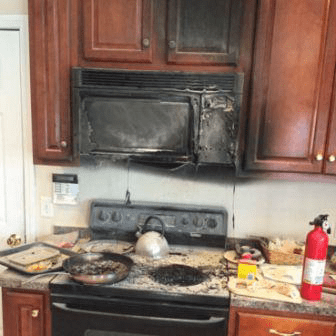Prevent Fire Damage by Choosing the Correct Extinguisher
We have seen every type of fire in our 20+ years of experience in fire damage restoration. There are different types of fire extinguishers made for different fires, like grease, chemical, and electrical. Each requires different methods to put out. It's very important to use the correct class of fire extinguishers, if not, a dangerous chemical reaction will occur. You never want to use water on a grease or electrical fire because this will only intensify the flames. There are five different types of fire extinguishers, learn more about how to prevent fire damage with this guide. 
Classes of Fire Extinguishers
Class A- Typically used in homes and offices to put out fires fueled by materials like cloth, wood, and paper. For example, a fire started by a cigarette improperly disposed of on the porch of a building or a candle left to burn too close to curtains. Class A uses water to extinguish the flames.
Class B- Also typically found in homes and businesses. This extinguisher is used to put out fires caused by combustible and flammable liquids like oil, gas, and oil-based paints. An example of this type of fire is a pile of greasy rags stored in a garage. Class B uses dry powder to extinguish.
Class C- Often used in homes and businesses to put out electrical fires from live wires or electrical panels. For example, when an outlet is overloaded with too many high-voltage electronics and causes a short in the system, sparking a fire.
Class D- Typically found in factories or labs to extinguish fires started with flammable metals like aluminum. A class D extinguisher uses a dry powder chemical to smother the flames.
Class K- Found in commercial kitchens like schools, restaurants, and cafeterias. Cooking fires are  caused by vegetable oils and animal fats. These extinguishers use a foam material to trap vapors and put a fire out. Our experienced technicians have worked to restore many commercial kitchen fires. As you can see in the photo below, this diner used a fire extinguisher to stop the spread of the fire.
caused by vegetable oils and animal fats. These extinguishers use a foam material to trap vapors and put a fire out. Our experienced technicians have worked to restore many commercial kitchen fires. As you can see in the photo below, this diner used a fire extinguisher to stop the spread of the fire.
You can also purchase a multi-purpose fire extinguisher labeled for ABC use or BC use. An ABC extinguisher uses chemicals designed to suppress the flames. You can see the tiny particles called Ansul dust remnants in these photos below. While they do tend to leave behind a mess, the fire damage would have been much worse if not contained by the fire extinguisher. A class BC extinguisher uses carbon dioxide to remove the oxygen from the fire to put out the flames.
You can also purchase a multi-purpose fire extinguisher labeled for ABC use or BC use. An ABC extinguisher uses chemicals designed to suppress the flames. You can see the tiny particles called Ansul dust remnants in these photos below. While they do tend to leave behind a mess, the fire damage would have been much worse if not contained by the fire extinguisher. A class BC extinguisher uses carbon dioxide to remove the oxygen from the fire to put out the flames.
.png)
Use this as a guide to choose the correct fire extinguisher for your needs. For more information on fire extinguishers and how to use them, please visit the US Fire Administration. Hopefully, you'll never have to worry about a fire in your home or business. But if the worst should happen, give ServiceMaster Dynamic Cleaning a call for fire damage restoration at (800) 865-5157.

